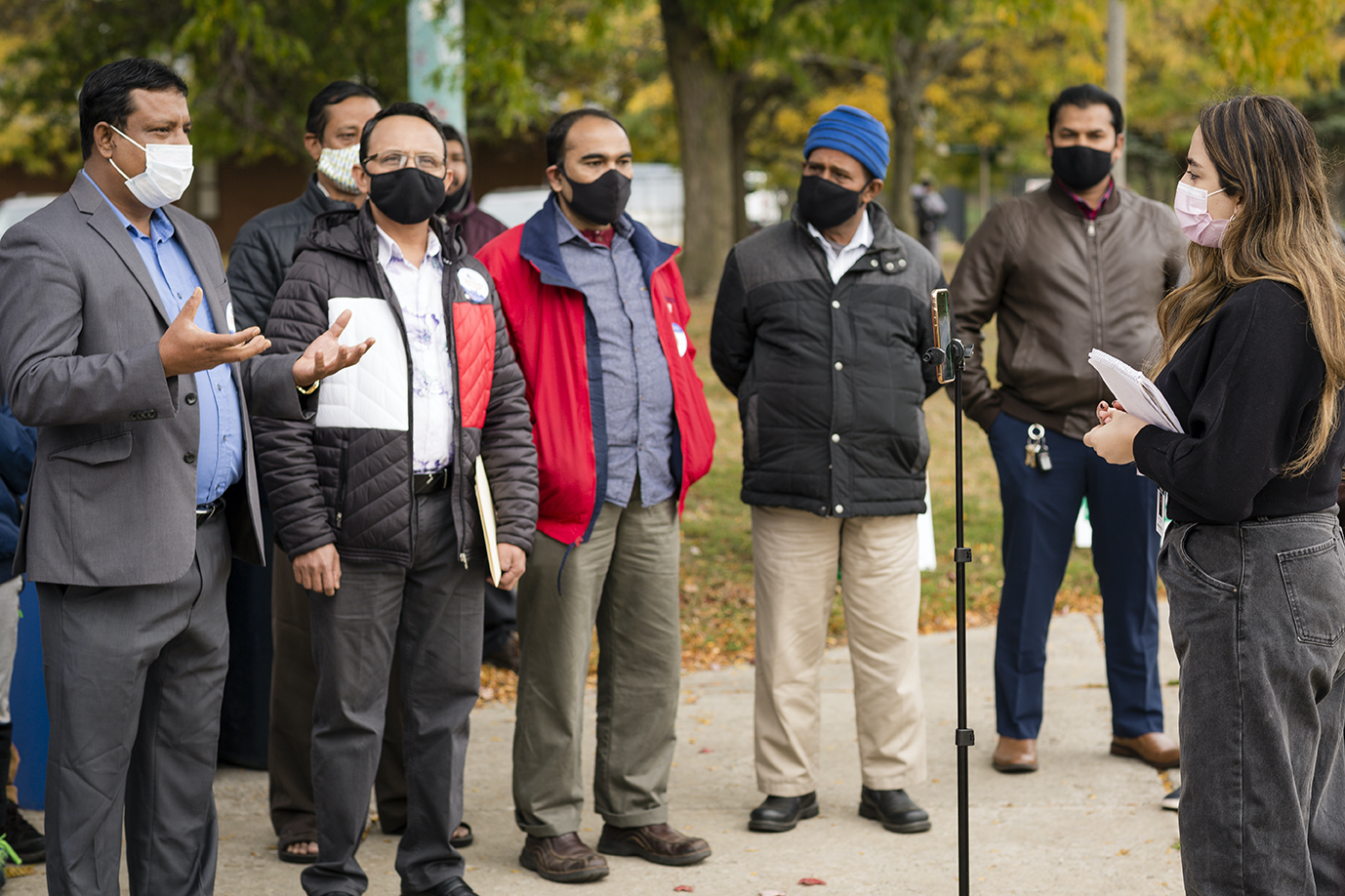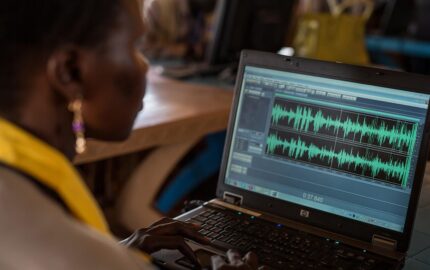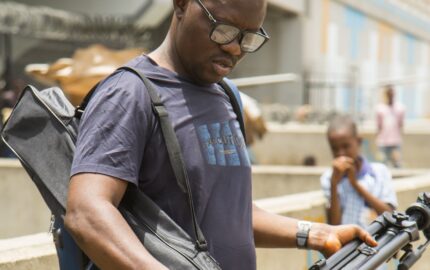Chicago is a city of immigrants. Over 1.6 million of them live in the metropolitan Chicago region I call home. And nearly one-third of households in Cook County, Illinois, include one or more immigrants.
Yet, Chicago’s local media is woefully under-serving immigrant populations in the region today.
There were over 130 local and national media outlets serving primarily immigrant audiences in Chicago in 2012. Today, just over half of those outlets remain despite the fact that our immigrant population is growing. The coronavirus pandemic has only accelerated this trend, with publications like Future News — the longest-running newspaper serving Arab American communities in the Midwest — shutting down after its publisher succumbed to the virus, and Spanish-language Univision laying off local staff.
Mainstream outlets could fill some of these gaps, but so far have made little effort to do so, preferring to see people from immigrant communities as a niche group served by “ethnic media” rather than an important part of their core audience.
This is, in part, a reflection of mainsteam journalism’s roots in white supremacy and longtime exclusion of Black, Latinx, Asian, Middle Eastern, and Native journalists and leaders in its newsrooms. Mainstream news programs and newspapers in Chicago, which once offered nuanced or bilingual coverage of immigrant communities, have closed shop in recent years, despite the fact that 36% of our city’s residents speak a language other than English at home.
These losses and similar closures elsewhere in the country of outlets that serve immigrants and their allies have come at a terrible cost. Nearly half of all immigrants in Chicago were eligible to vote in the 2020 presidential election. Yet, we know that when communities lose news coverage, people become less likely to vote or run for office. The loss of transparency and accountability created by journalists can also lead to increases in corruption, taxes, and misinformation.
In the absence of fair, accessible, and accurate media coverage of and for immigrants, misinformation and fake news have spread. Spanish-speaking immigrants, for example, have become targets of disinformation campaigns that are “helping plunge the country further into chaos and confusion,” according to Fadi Quran of Avaaz, a nonprofit promoting global activism on various issues that tracks disinformation.
So how can journalists better serve immigrants and their communities?
At Borderless Magazine, we believe it’s going to take a radical reimagining of immigration journalism to make it more responsive to the information needs of our multicultural and multilingual communities.
In Chicago, we are doing this work through our multilingual people-centered reporting, our Pathways mentoring program, and our Immigration Reporting Lab. These three programs respond to the information and language needs of immigrants and aim to create a more representative media landscape that includes their voices and experiences.
Our small team covers labor, justice, and advocacy issues impacting Midwestern immigrant communities through a lens of equity and resilience. In 2020, we published 92 deeply-reported stories that held the powerful accountable on issues ranging from racism and labor to the Covid-19 pandemic and the immigration detention system.
The features and investigations that we published in 2020 helped temporarily shut down the Chicago Immigration Court to address Covid-19 safety concerns, helped a undocumented homeless student pay her college tuition, and uplifted the voices of former Rohingya refugees who were voting for the first time at a Chicago polling place in November.
In 2020, 94% of Borderless Magazine’s stories were written, photographed, or illustrated by people from African, Latinx, Asian, Indigenous, or Middle Eastern communities. Our top ten most-read stories of last year include features written in English, Spanish, Filipino, and Mandarin. The stories were written by people whose families come from the Philippines, Lebanon, Iraq, Mexico, and El Salvador.
We are proud of these accomplishments but know that we alone cannot fill the gap in the media ecosystem in our region. That’s why Borderless Magazine also provides pathways for emerging journalists from immigrant and other marginalized communities to report on immigration and learn from professional journalists. We mentor emerging journalists through a mix of paid and unpaid internships, fellowships, and one-off projects in our Pathways program. Our award-winning team gives mentees comprehensive training in interviewing, writing, research, and visual storytelling.
Borderless Magazine is also giving journalists and newsrooms the tools they need to responsibly report on immigration through our Immigration Reporting Lab. As part of these efforts, we conducted listening sessions with leaders at immigrant-serving organizations and surveyed 47 of our readers during the summer of 2020 to better understand the needs of Chicagoans when it comes to news coverage of immigrant communities.
The result is our 20-page report, “The State of Immigration News in Chicago,” which we released today. The report outlines ten steps journalists in Chicago and elsewhere can take to better serve our immigrant audiences.
These include publishing more, deeper, and fairer coverage of immigration that centers on diverse voices and individual experiences. Chicagoans we spoke to asked journalists to look into the complex connections between the U.S. criminal justice system, our local governments, and our immigration detention system, which is the largest in the world.
They also asked for reporting that eschews the dehumanizing labels used by white supremacists to refer to immigrants and provides a more nuanced view of immigration, mirroring long-standing asks from our African-American community here for more balanced coverage.
While this work will not be easy, in our first full year of operations, we have proven that there is a hunger for this kind of journalism.
Our work of reimagining immigration journalism is just starting. Last week’s white supremacist violence in Washington, D.C., should serve as a reminder of the urgent work we need to do as journalists to combat misinformation and racist rhetoric. In 2021, newsrooms can no longer afford to continue to ignore immigrants and journalists of color and must embrace them as part of our core audience.
This year, we hope you will join us in this work so that we can build a more responsive journalism industry together.
Nissa Rhee is a Peabody-award nominated journalist and the executive director of the nonprofit news outlet, Borderless Magazine.
Yet, Chicago’s local media is woefully under-serving immigrant populations in the region today.
There were over 130 local and national media outlets serving primarily immigrant audiences in Chicago in 2012. Today, just over half of those outlets remain despite the fact that our immigrant population is growing. The coronavirus pandemic has only accelerated this trend, with publications like Future News — the longest-running newspaper serving Arab American communities in the Midwest — shutting down after its publisher succumbed to the virus, and Spanish-language Univision laying off local staff.
Mainstream outlets could fill some of these gaps, but so far have made little effort to do so, preferring to see people from immigrant communities as a niche group served by “ethnic media” rather than an important part of their core audience.
This is, in part, a reflection of mainsteam journalism’s roots in white supremacy and longtime exclusion of Black, Latinx, Asian, Middle Eastern, and Native journalists and leaders in its newsrooms. Mainstream news programs and newspapers in Chicago, which once offered nuanced or bilingual coverage of immigrant communities, have closed shop in recent years, despite the fact that 36% of our city’s residents speak a language other than English at home.
These losses and similar closures elsewhere in the country of outlets that serve immigrants and their allies have come at a terrible cost. Nearly half of all immigrants in Chicago were eligible to vote in the 2020 presidential election. Yet, we know that when communities lose news coverage, people become less likely to vote or run for office. The loss of transparency and accountability created by journalists can also lead to increases in corruption, taxes, and misinformation.
In the absence of fair, accessible, and accurate media coverage of and for immigrants, misinformation and fake news have spread. Spanish-speaking immigrants, for example, have become targets of disinformation campaigns that are “helping plunge the country further into chaos and confusion,” according to Fadi Quran of Avaaz, a nonprofit promoting global activism on various issues that tracks disinformation.
So how can journalists better serve immigrants and their communities?
At Borderless Magazine, we believe it’s going to take a radical reimagining of immigration journalism to make it more responsive to the information needs of our multicultural and multilingual communities.
In Chicago, we are doing this work through our multilingual people-centered reporting, our Pathways mentoring program, and our Immigration Reporting Lab. These three programs respond to the information and language needs of immigrants and aim to create a more representative media landscape that includes their voices and experiences.
Our small team covers labor, justice, and advocacy issues impacting Midwestern immigrant communities through a lens of equity and resilience. In 2020, we published 92 deeply-reported stories that held the powerful accountable on issues ranging from racism and labor to the Covid-19 pandemic and the immigration detention system.
The features and investigations that we published in 2020 helped temporarily shut down the Chicago Immigration Court to address Covid-19 safety concerns, helped a undocumented homeless student pay her college tuition, and uplifted the voices of former Rohingya refugees who were voting for the first time at a Chicago polling place in November.
In 2020, 94% of Borderless Magazine’s stories were written, photographed, or illustrated by people from African, Latinx, Asian, Indigenous, or Middle Eastern communities. Our top ten most-read stories of last year include features written in English, Spanish, Filipino, and Mandarin. The stories were written by people whose families come from the Philippines, Lebanon, Iraq, Mexico, and El Salvador.
We are proud of these accomplishments but know that we alone cannot fill the gap in the media ecosystem in our region. That’s why Borderless Magazine also provides pathways for emerging journalists from immigrant and other marginalized communities to report on immigration and learn from professional journalists. We mentor emerging journalists through a mix of paid and unpaid internships, fellowships, and one-off projects in our Pathways program. Our award-winning team gives mentees comprehensive training in interviewing, writing, research, and visual storytelling.
Borderless Magazine is also giving journalists and newsrooms the tools they need to responsibly report on immigration through our Immigration Reporting Lab. As part of these efforts, we conducted listening sessions with leaders at immigrant-serving organizations and surveyed 47 of our readers during the summer of 2020 to better understand the needs of Chicagoans when it comes to news coverage of immigrant communities.
The result is our 20-page report, “The State of Immigration News in Chicago,” which we released today. The report outlines ten steps journalists in Chicago and elsewhere can take to better serve our immigrant audiences.
These include publishing more, deeper, and fairer coverage of immigration that centers on diverse voices and individual experiences. Chicagoans we spoke to asked journalists to look into the complex connections between the U.S. criminal justice system, our local governments, and our immigration detention system, which is the largest in the world.
They also asked for reporting that eschews the dehumanizing labels used by white supremacists to refer to immigrants and provides a more nuanced view of immigration, mirroring long-standing asks from our African-American community here for more balanced coverage.
While this work will not be easy, in our first full year of operations, we have proven that there is a hunger for this kind of journalism.
Our work of reimagining immigration journalism is just starting. Last week’s white supremacist violence in Washington, D.C., should serve as a reminder of the urgent work we need to do as journalists to combat misinformation and racist rhetoric. In 2021, newsrooms can no longer afford to continue to ignore immigrants and journalists of color and must embrace them as part of our core audience.
This year, we hope you will join us in this work so that we can build a more responsive journalism industry together.
Nissa Rhee is a Peabody-award nominated journalist and the executive director of the nonprofit news outlet, Borderless Magazine.



